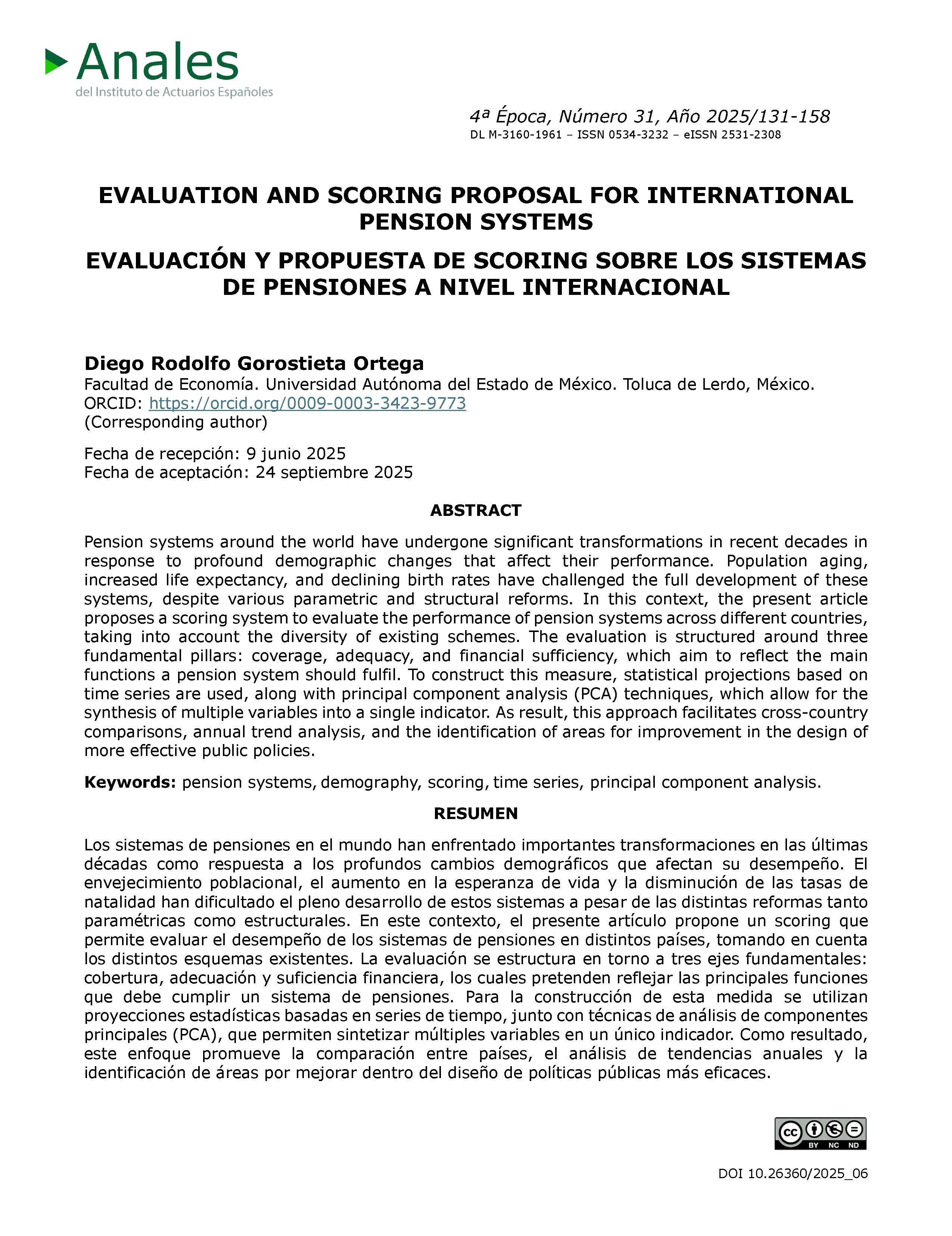Evaluación y propuesta de scoring sobre los sistemas de pensiones a nivel internacional
DOI:
https://doi.org/10.26360/2025_06Palabras clave:
sistemas de pensiones, demografia, scoring, series de tiempo, análisis de componentes principalesResumen
Los sistemas de pensiones en el mundo han enfrentado importantes transformaciones en las últimas décadas como respuesta a los profundos cambios demográficos que afectan su desempeño. El envejecimiento poblacional, el aumento en la esperanza de vida y la disminución de las tasas de natalidad han dificultado el pleno desarrollo de estos sistemas a pesar de las distintas reformas tanto paramétricas como estructurales. En este contexto, el presente artículo propone un scoring que permite evaluar el desempeño de los sistemas de pensiones en distintos países, tomando en cuenta los distintos esquemas existentes. La evaluación se estructura en torno a tres ejes fundamentales: cobertura, adecuación y suficiencia financiera, los cuales pretenden reflejar las principales funciones que debe cumplir un sistema de pensiones. Para la construcción de esta medida se utilizan proyecciones estadísticas basadas en series de tiempo, junto con técnicas de análisis de componentes principales (PCA), que permiten sintetizar múltiples variables en un único indicador. Como resultado, este enfoque promueve la comparación entre países, el análisis de tendencias anuales y la identificación de áreas por mejorar dentro del diseño de políticas públicas más eficaces.
Descargas
Citas
Ablanedo, E. & Barón, A. (2020). Análisis de los sistemas de pensiones europeos e internacionales. Iniciativa de la Unión Europea para la protección social, el trabajo y el empleo. https://socieux.eu/wp-content/uploads/2020/06An%C3%A1lisis_de_los_Sistemas_de_Pensiones.pdf
Aldás, J. & Uriel, E. (2017). Análisis multivariante aplicado con R. Ediciones Paraninfo. Madrid, España.
Alonso-Fernández, J.-J., Meneu-Gaya, R., Devesa-Carpio, E., Devesa-Carpio, M., Domínguez-Fabian, I. & Encinas-Goenechea, B. (2018). From the Replacement Rate to the Synthetic Indicator: A Global and Gender Measure of Pension Adequacy in the European Union. Social Indicators Research, 138(1), 165–186. https://www.jstor.org/stable/48715115
Barr, N. & Diamond, P. (2006). The economics of pensions. Oxford Review of Economics Policy, 22.
Bigss, A. & Springstead, G. (2008). Alternate measures of replacement rates for social security benefits and retirement income. Social Security Bulletin, 68(2), 1–19. PMID: 19102135.
Bodie, Z., Shoven, J. B., & Wise, D. A. (1988). Pensions in the U.S. Economy. University of Chicago Press.Box, G. & Cox, D. (1964). An analysis of transformations (with discussion). Journal of the Royal Statistical Society, Series B, 26, 211–252.
Box, G. Jenkins, G., Reinsel, G. & Ljung, G. (2016). Time series Analysis Forecasting and Control (5). Wiley.
Broby, D., & Smyth, W. (2025). On the use of principal components analysis in index construction.https://systems.enpress-publisher.com/index.php/FSJ/article/view/10858/5404
Brockwell, P. & Davis, R. (2002). Introduction to Time Series and Forecasting (2). Springer.
Chao, Y. & Wu, C. (2017). Principal component-based weighted indices and a framework to evaluate indices: Results from the Medical Expenditure Panel Survey 1996 to 2011. PLoS ONE, 12(9), e0183997. https://doi.org/10.1371/journal.pone.0183997
Charrad, M., Ghazzali, N., Boiteau, V. & Niknafs, A. (2014). NbClust: An R Package for Determining the Relevant Number of Clusters in a Data Set. Journal of Statistical Software, 61(6), 1–36. https://www.jstatsoft.org/v61/i06/
Charrad, M., Ghazzali, N., Boiteau, V. & Niknafs, A. (2022). NbClust: An R Package for Determining the Relevant Number of Clusters in a Data Set. R package version 3.0.1. https://CRAN.R-project.org/package=NbClust
Chybalski, F. (2015). The Multidimensional Efficiency of Pension System: Definition and Measurement in Cross-Country Studies. Social Indicators Research, 128, 15–34. https://doi.org/10.1007/s11205-015-1017-3
Chybalski, F. & Marcinkiewicz, E. (2016). The Replacement Rate: An Imperfect Indicator of Pension Adequacy in Cross-Country Analyses. Social Indicators Research, 126, 99–117. https://doi.org/10.1007/s11205-015-0892-y
Clark, R., Craig, L. & Wilson, J. (2003). A History of Public Sector Pensions in the United States. Pension Research Council, The Wharton School of the University of Pennsylvania.
Cole, C. & Liebenberg, A. (2008). An examination of retirement income adequacy measures and factors affecting retirement preparedness. Available at SSRN http://ssrn.com/abstract=1272067 or http://dx.doi.org/10.2139/ssrn.1272067
Conde-Ruíz, J. & González, C. (2018). European pension system: Bismarck or Beveridge?. Fundación de Estudios de Economía Aplicada. https://documentos.fedea.net/pubs/dt/2018/dt2018-01.pdf
Contreras, C. (2020). Modelo deseable para un sistema de pensiones igualitario, justo y sostenible. Conferencia Interamericana de Seguridad Social. https://ciss-bienestar.org/cuadernos/pdf/modelo-deseable-para-un-sistema-de-pensiones-igualitario-justo-y-sostenible.pdf
Cowpertwait, P. & Metcalfe, A. (2009). Introductory Time Series with R. Springer. Das, J. (2015). Business Forecasting: Box-Jenkins Methodology. University of Calcutta. https://www.researchgate.net/publication/342551929_Business_Forecasting_Box-Jenkins_Methodology
Devesa-Carpio, E., Rosado-Cebrian, B. & Álvarez-García, J. (2020). Sustainability of Public Pension Systems, Springer Books, in: Peris-Ortiz, M., Álvarez-García, J., Domínguez-Fabián, I., Devolder, P. (ed.), Economic Challenges of Pension Systems, chapter 8, pages 125-154, Springer.
Fernández, P. (2003). El Aerarium Militare. Espacio, Tiempo y Forma, Serie II, Historia Antigua, 16, 197-214.
Gallagher, N., Sullivan, D. & Palacios, M. (2020). The Effect of Data Centering on PCA Models. Eigenvector Research Incorporated. https://eigenvector.com/wp-content/uploads/2020/06/EffectofCenteringonPCA.pdf
Guven, U. & Holzmann, R. (2009). Adequacy of Retirement Income after Pension Reforms in Central, Eastern, and Southern Europe: Eight Country Studies. Directions in Development; finance. World Bank. http://hdl.handle.net/10986/2610
Husson, F., Lê, S. & Pagès, J. (2011). Exploratory Multivariate Analysis by Example Using R. CRC press.
Hyndman, R.J. & Khandakar, Y. (2008). Automatic time series forecasting: the forecast package for R. Journal of Statistical Software, 27(3), 1–22. doi:10.18637/jss.v027.i03
Hyndman, R., Athanasopoulos, G., Bergmeir, C., Caceres, G., Chhay, L., O'Hara-Wild, M., Petropoulos, F., Razbash, S., Wang, E. & Yasmeen, F. (2024). forecast: Forecasting functions for time series and linear models. R package version 8.23.0. https://pkg.robjhyndman.com/forecast/.
Jiménez, L. & Cuadros J. (2003). Evaluación de las reformas a los sistemas de pensiones: cuatro aspectos críticos y sugerencias de políticas. Unidad de Estudios Especiales, Secretaría Ejecutiva: Comisión Económica para América Latina y el caribe. https://repositorio.cepal.org/server/api/core/bitstreams/5fc288c1-eff5-41fb-b368-ef1ca178b142/content
Knoef, M., Been, J., Alessie, R., Caminada, K., Goudswaard, K. & Kalwij, A. (2016). Measuring retirement savings adequacy: developing a multi-pillar approach in the Netherlands. Journal of Pension Economics and Finance, 15(1), 55–89. https://doi.org/10.1017/S1474747214000341
Lê S., Josse J. & Husson F. (2008). FactoMineR: A Package for Multivariate Analysis. Journal of Statistical Software, 25(1), 1–18.
Meneu-Gaya, R., Encinas-Goenechea, B. & Domínguez-Fabián, I. (2020). Equity of Public Pension System, Springer Books, in: Peris-Ortiz, M., Álvarez-García, J., Domínguez-Fabián, I., Devolder, P. (ed.), Economic Challenges of Pension Systems, chapter 8, pages 155-172, Springer.
Mercer. (2023). Índice Global de Pensiones de Mercer CFA Institute 2023. https://www.mercer.com/es-ar/insights/investments/market-outlook-and-trends/mercer-cfa-global-pension-index/
Mesa-Lago, C. (2020). Evaluation of Four Decades of Pension Privatization in Latin America, 1980-2020: Promises and Reality. SSRN Electronic Journal. https://papers.ssrn.com/sol3/Delivery.cfm/SSRN_ID3812430_code2517124.pdf?abstractid=3812430&mirid=1
Mesa-Lago, C. (2022). Pensiones de capitalización individual en América Latina: efectos, reformas, impacto del COVID-19 y propuestas de política. Políticas Sociales. Comisión Económica para América Latina y el Caribe. https://repositorio.cepal.org/server/api/core/bitstreams/c973ffd4-2bf6-4c4c-912b-49c3c8d5cedd/content#:~:text=Los%20pa%C3%ADses%20tratados%20son%20Bolivia,Rep%C3%BAblica%20Dominicana%20y%20el%20Uruguay.
Palmer, B. (1989). Tax Reform and Retirement Income Replacement Ratios. The Journal of Risk and Insurance, 56(4), 702-725.
Pokorný, J. (2020). Evaluation of pension sustainability and its application. Economic Spectrum, 15.
R Development Core Team (2024). R: The R project for statistical computing. Vienna (Austria). http://www.R-project.org/
Rosado-Cebrian, B., Peris-Ortiz, M. & Rueda-Armengot, C. (2020). Adequacy of Public Pension Systems, Springer Books, in: Peris-Ortiz, M., Álvarez-García, J., Domínguez-Fabián, I., Devolder, P. (ed.), Economic Challenges of Pension Systems, chapter 8, pages 173-191, Springer.
Scheubel, B. (2013). Bismarck’s Pension System. Bismarck's Institutions: A Historical Perspective on the Social Security Hypothesis (pp.77-104).
Mohr Siebeck GmbH and Co. KG Shumway, R. & Stoffer, D. (2006). Time Series analysis and Its applications With R Examples (2). Springer.
Social Security Administration. (2023). International Update: Recent Developments in Foreign Public and Private Pensions (International Update). Office of Policy, Office of Research, Evaluation, and Statistics, U.S. Social Security Administration.https://www.ssa.gov/policy/docs/progdesc/intl_update/2023-03/index.html
Subsecretaría de Previsión Social. (2024). Sistema de Pensiones, Pilares del sistema de pensiones. Subsecretaría de Previsión Social: Gobierno de Chile. https://previsionsocial.gob.cl/seguridad-social/sistema-de-pensiones/#:~:text=El%20sistema%20de%20pensiones%20chileno,de%20propiedad%20de%20cada%20trabajador.
United Nations. (2017). World Population Prospects The 2017 Revision. Department of Economic and Social Affairs, Population Division. https://population.un.org/wpp/publications/files/wpp2017_keyfindings.pdf
World Bank Group (1994). Averting the old age crisis: policies to protect the old and promote growth. World Bank Group: Washington, D.C. http://documents.worldbank.org/curated/en/973571468174557899/Averting-the-old-age-crisis-policies-to-protect-the-old-and-promote-growth
World Bank Group (2008). The World Bank pension conceptual framework. World Bank pension reform primer series. World Bank Group: Washington, D.C. http://documents.worldbank.org/curated/en/389011468314712045/The-World-Bank-pension-conceptual-framework
World Health Organization. (2022). Ageing and health. World Health Organization: Newsroom. https://www.who.int/news-room/fact-sheets/detail/ageing-and-health
Yuh, Y. (2011). Assessing Adequacy of Retirement Income for U.S. Households: A Replacement Ratio Approach. The Geneva Papers on Risk And Insurance - Issues And Practice, 36(2), 304-323. https://doi.org/10.1057/gpp.2011.7

Publicado
Cómo citar
Número
Sección
Licencia
Derechos de autor 2025 Diego Rodolfo Gorostieta Ortega

Esta obra está bajo una licencia internacional Creative Commons Atribución-NoComercial-SinDerivadas 4.0.

















